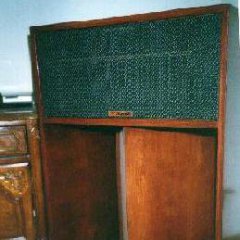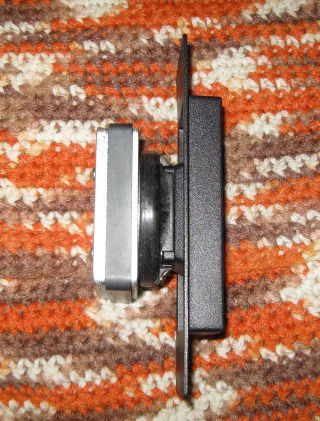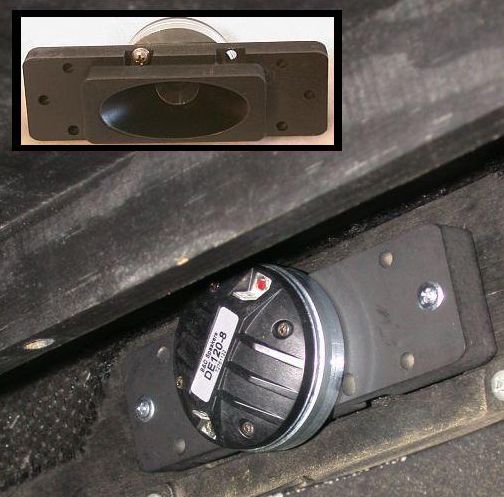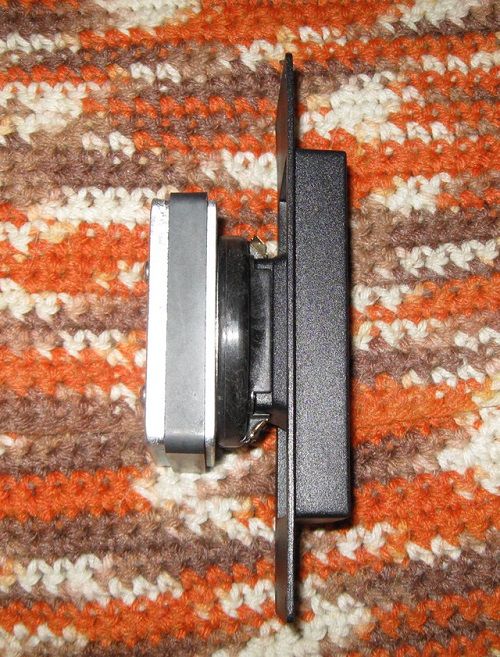-
Posts
5893 -
Joined
-
Last visited
-
Days Won
1
Content Type
Forums
Events
Gallery
Everything posted by JohnA
-
Us And Them.
-
That curve is not so bad, but I'd put them on a long wall, 3 or 4 feet away from a corner and ~18" off the back wall to start.
-
Toe-out makes steering response more sensitive and less stable. 😉 Many speakers have a response curve that rises with increasing frequency. Toeing out puts the listener off-axis where the response normally falls with increasing frequency. That may make the speaker sound more pleasing and why your friend likes it. There is some research out there saying more people prefer the falling response, to the tune of about 3 dB/octave. OTOH, toeing out throws more energy into the reflected sound/reverberant field, re:Blose. Reduced reflected sound has been a stated objective of Klipsch for decades. You paid for them, place them as you like.
-
Just for giggles, what are the letter codes stamped in the corners in the back edges? One of our members may have built yours, or helped.
-
1984 used K-77-M. Try to find K-77-F or -D. The flanges push the tweeter's mouth flush with the front of the motorboard. That will sound clearer.
-
No, ODS is poking the bears.
-
Having heard them, and at no time loud, I can fully state none of that is true. Someone making that statement could not have heard C IVs. The midrange horn and driver are both new, I'm pretty sure the tweeter is new, at least from the C III. The box is new as are the Tractrix ports. These have a flare at both ends to smooth air flow into and out of the box. That is not antiquated/Old School. They WERE spectacular with a tube amp system provided be Paducah Home Theater. (Hint!) After about 5 months with my new Heresy IVs, I cannot recommend them enough. For your described use, and dedicated listening, too, they are also EXCELLENT. They have enough low bass output to just reach the low E on a bass; all you need. No subwoofer is needed. Finally, Forte IIIs have a similar squawker horn to C IVs and seem to me to meet your desires. Having heard them, too, they have a familial sound you may like, with deeper bass, if you like organ music.
-
Any receiver over 25 watts/channel should be enough; 100 watts/ch is plenty. If they're in one room, you might be able to use them as a theater system. Look at Yamaha, Denon, Onkyo/Integra, Sony, Sony ES and Marantz. Most of those will have Bluetooth.
-
Yeah, but I bet the steak-bobs are tasty on those!
-
I'm pretty sure all La Scala IIs ARE split cabinets. But the Type AL-4 xover was used in one piece La Scalas, too. "SOMEBODY" at Cheif Bonehead's class had a loose pair of AL-4s that I'd love to get my hands on. It was like pulling teeth to get him to admit it. 😉
-
The Type AL-4 began in 2004, I think. We were shown early production or final prototype models at an early Pilgrimage in Indy about 2004/5. The first AL-4s were in plywood La Scalas like yours. They sounded remarkably familiar, much like my Type AAs with Hovland Musicaps.
-
Ooooh! Looking purty!! I'm SURE you can hear that difference. Is there a wall or object 9" away from the squawker? The dips at 1500 and 3000 might be a reflection.
-
I'm with Bill. 60 Hz, depending on your H IV's location. Follow Klipsch's recommendations. I'd also recommend getting a sound meter to help calibrate the sub level. Quick and dirty, if you can tell there is a sub in the system, its too loud.
-
No. We paid for a seminar on Klipsch engineering and history. I did not like the H IIIs and got to hear some of my music on Cornwall IVs through a nice tube amp in the lecture room. They are B.A. impressive. Music just appears out of somewhere behind the grille. You don't hear components and I could not locate the 3 drivers like I can with older Klipsch, like my H700s and H Is. My impression of the Klipschorn Jubilees is much different now that it was in 2001, too. Based on the 2001 audition, I have been surprised at it's popularity around here.
-
You must be like the Indian that washes with dirt and dries with water and walks backward, just to be contrary.
-
While I also prefer the Type AA Network, don't turn down an AL-2 or AL-3. Look for raw birch to make your finishing job easier and expect to do it or pay for it after you get them.
-
That loose wire would have had me all out of sorts with my new, $$$ La Scalas, too. I'm curious about the green line being ~5 dB below the red line, though.
-
Just beautiful! though it may sound delicious, I'd knock down the bump at 40 Hz and be proud.
-
In general, the things that change signals from one type to another, electrical to mechanical (speakers, phono cartridges) or digital to analog make the most difference. What is your complaint about the system? Your square room will be a thorn in your sound perpetually. How have you treated it? Where is the subwoofer placed? Without seeing it and based on your square room, I'd put it between the speakers and about 2 feet either side of the center of the wall in an attempt minimize room resonances. I might also try placing the 160s on either side of a corner, again to randomize resonances and not close to 4.75 feet off the floor. If you are looking for quality, mp3 based (streaming) media isn't it. You want hi-res DVD-Audio, LPs or CD/SACD. I have not tried lossless streaming, what is the source for the lossless encoding? I do a lot of streaming, but only for background/casual listening, like working on the car.
-
Angelaudio, I'm not convinced the larger tube amp returns better bass because of power. It has a different arcitecture. Low powered tube amps, typically SET, as yours appears, tend to vary frequency response by impedance and often roll off the low bass. If yours is doing that, it could explain your results. I will take my H IVs over H1s or HIPs (with solder terminal -Vs in all of them) whenever possible. And did.
-
Actually you are incorrect. My H IVs were the first speakers I've bought new in about 35 years. After an hour I thought I had made a mistake. So, I found some dub step and other bassy music online and played them 24H/day, at moderate levels with max bass boost. After 3 days they sounded more like what I heard in Hope. After 7 days, they sounded like Roy's demo speaker and I quit the foolishness. I did not believe in speaker break-in before this. I still think some people/situations need some ear adjustment time, but for woofers, an extended break-in is real. Klipsch even does a break-in on woofers by running them at a low frequency for a handful of hours before testing.
-
I shoulda added this: https://www.parts-express.com/gold-dual-binding-post-banana-jack--091-335
-
P is 1976. There were 9780 Cornwalls made before that one. https://community.klipsch.com/index.php?/topic/161759-klipsch-heritage-codes/
-
I don't think it will hurt. 2.2 is just +10% and +/- 10% is a commonly allowed tolerance in crossover components. OTOH, two 1.0 uF caps in parallel make 2.0 uF. Solen in France makes teflon and polypropylene film and foil caps in 2.0 uF. You might check with Falcon Acoustics to see if they can get them for you. https://solen.ca/products/capacitors/film-foil-polypropylene-capacitors/se200/
-
What I did and would do again, in approximately this order: 1- Replace the capacitors in the crossover with good film and foil caps. NOT metalized, this is a K-horn. 2- Change the K-55-Vs to '80s era solder terminal drivers. The attached Dope From Hope shows why. 3- Flush mount the tweeters with the front of the upper motorboard. You can use newer Klipsch K-77-F with a flange that pushes the mouth forward 3/4" or an aftermarket horn and tweeter driver. A K-77-M and later versions have more output above 12kHz. 4- Line the opening in the motorboard for the K-400 with heavy stick-on felt to reduce diffraction by the edge. 5- Wrap the K-400 in heavy Dynamat, or similar to kill a small ringing. Play a powerful female voice, like Thelma Houston. loud, and wrap your hand around the K-400 in front of the K-55 to see why. 6- Stuff the upper/treble cabinet with polyester pillow fill. Knock on the top to see why. 7- Consider adding the 0.4 mH inductor I put in the Squawker circuit to make it a bandpass circuit and attenuate some extra output a K-55-V has at 9 kHz as well as reducing overlap between the 2 drivers. You can do these one at a time, or all at once. I did them over a couple of years as I listened and identified smaller and smaller flaws in my speakers.










